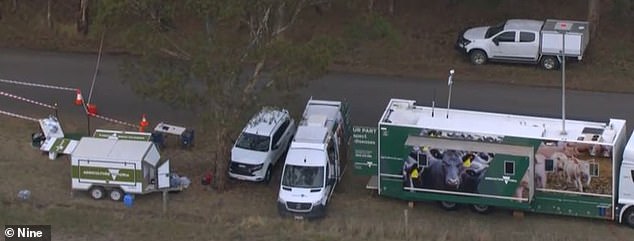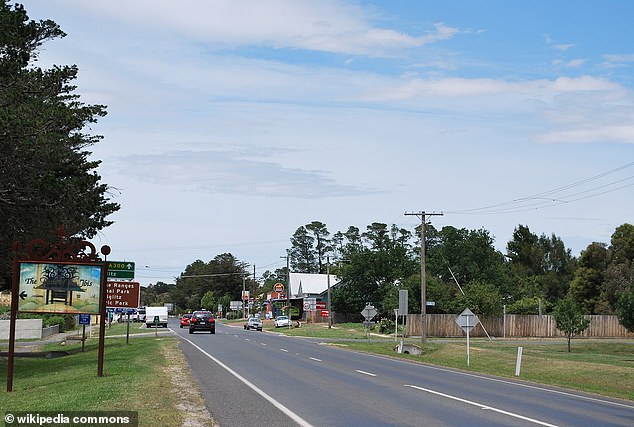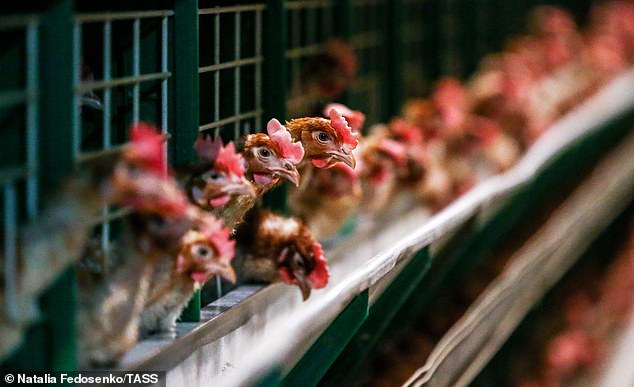Bird flu spreads to third Australian farm as 400,000 chickens are slaughtered to halt spread of the virus – day after it emerged child became infected
Another farm in Australia has been hit by a case of bird flu. About 400,000 chickens will be slaughtered to stop the spread of the disease.
Health officials and farmers are on high alert after the second case of avian flu, a contagious infection in birds, was discovered on a rural property in Terang, 141km west of Geelong, Victoria, on Thursday.
Bird flu is a highly contagious viral infection that can cause severe symptoms and sudden death in domestic poultry, wiping out entire populations.
The farm is the third place the disease has been discovered, after the virus was found on Wednesday at an egg farm in Meredith, also in western Victoria, and a less dangerous variant was discovered in Western Australia.
A second case of highly contagious bird flu, also known as avian flu, has been discovered at another farm in Victoria (pictured health workers in hazmat suits arrive at an egg farm in Meredith, western Victoria, after the disease was discovered on a property)
The disease was discovered after several poultry deaths at the Terang farm, while the mass slaughter of around 400,000 chickens is now underway on the site.
Agriculture Victoria said the H7N3 strain of the virus has also been found on the Terang property, with the virus linked to the Meredith egg farm.
“The property is located in the Terang region and is linked to the property in Meredith, where the highly pathogenic H7N3 strain of avian flu virus has resulted in numerous poultry deaths,” Agriculture Victoria said in a statement on Thursday.
‘Control orders are in place restricting the movement of poultry, poultry products, equipment and vehicles onto or off properties in designated areas around the two infected buildings.’
Agriculture Victoria said a 1.5 kilometer area around the Terang farm has been closed by health and safety workers, while a 15 kilometer buffer zone has also been established.
Earlier, dozens of health workers, overseen by Agriculture Victoria officials, arrived at the farm in Meredith wearing hazmat suits, masks and other protective gear in grim scenes.
Several vehicles were also seen delivering large gas cylinders after the premises were quarantined and contact tracing began.

Health officials and farmers are on high alert after the H7N3 variant of the flu was discovered on two farms (pictured health workers and officials near a rural estate in Meredith, Victoria)

The virus strain at the Terang farm is linked to the disease found at the Meredith egg farm (pictured) on Wednesday
Despite concerns that the virus could be deadly, health officials said the H7N3 variant of bird flu does not pose a major health threat.
‘This is not the type of bird flu that poses a risk to humans [has a] very small risk [and there are] There are very few cases globally,” said Dr Graeme Cook, Chief Health Officer of Victoria Health Nine news.
‘It is completely safe to consume eggs and continue to eat poultry’
The cases come after a young child who arrived in Victoria from India in March became the first confirmed case of bird flu on Wednesday after contracting the more virulent H5N1 strain.
‘Contact tracing has not identified any further cases of bird flu associated with this case.’ Victoria’s chief health officer Dr Clare Looker said.
Another case of the virus, unrelated to the outbreaks in Victoria, has been found on a farm in Western Australia.
Department of Primary Industries and Regional WA acting Chief Veterinary Officer Katie Webb, told Daily Mail Australia in a statement that the department is aware of the matter.

Bird flu has resulted in several deaths among poultry, but health officials have stated that the variant of the disease found is not virulent and that people should not worry about poultry products sold in supermarkets (photo stock image)
“The Department of Primary Industries and Regional Development is managing the detection of low pathogenic H9N2 bird flu at a poultry farm in the south-west of Western Australia,” Ms Webb said.
‘DPIRD has worked with the affected poultry farm to manage detection and reduce the chance of spread, and implement additional biosecurity measures to reduce the risk of new introductions by wild birds.’
The H5N1 strain of bird flu continues to spread among bird populations around the world.
More than 90 million poultry in the US have been affected by the disease, according to figures from the Centers for Disease and Control Prevention.
“While cases among people who come into direct contact with animals infected with highly pathogenic avian influenza viruses are possible, the current risk to the public remains low,” Agriculture Victoria said.

